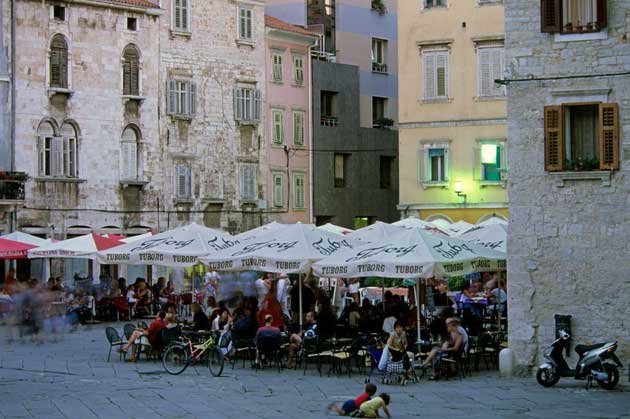Schnitzel and chips is off the menu in Pula
Croatia's Roman city on the Istrian peninsula is reinventing itself as a centre for gastro tourism and wine-making, Adrian Mourby reports

Your support helps us to tell the story
From reproductive rights to climate change to Big Tech, The Independent is on the ground when the story is developing. Whether it's investigating the financials of Elon Musk's pro-Trump PAC or producing our latest documentary, 'The A Word', which shines a light on the American women fighting for reproductive rights, we know how important it is to parse out the facts from the messaging.
At such a critical moment in US history, we need reporters on the ground. Your donation allows us to keep sending journalists to speak to both sides of the story.
The Independent is trusted by Americans across the entire political spectrum. And unlike many other quality news outlets, we choose not to lock Americans out of our reporting and analysis with paywalls. We believe quality journalism should be available to everyone, paid for by those who can afford it.
Your support makes all the difference.Pula has been Venetian, Austrian, Italian and Yugoslavian in its time. Now it's Croatian. Gina may have seen it all. She has been running restaurants in this small walled city since 1947. Her dyed hair is coiffed like Mme Pompadour, as she fixes me with a stare. "Iz daleki?" ("He is from far away?")
Bruno and Oz agree. Bruno is a wine producer. Oz markets Gourmet Istria. The three of us have ended up in Gina's restaurant late this dark March afternoon. And I have, indeed, come a long way to discover how this soil-rich region is reinventing itself as a major centre for gastro tourism.
Bruno used to work in his mother's accountancy business, but substantial government grants to develop Istria's wine potential started him brewing in the family garage. Now he has his own vineyard and the garage is full of 2,000-litre stainless steel fermentation tanks as well as oak barrels bought from France at €700 a piece. His malvasia is the best I have tasted so far.
Oz is half-Kenyan, half-Croatian. He lives on his nerves and his mobile phone and markets Gourmet Istria with a passion. He rejects the old communist days when there was no incentive to do better. He hates mass tourism and despises Istria's Albanian restaurants that offer Wiener schnitzel with chips every July and August.
"To be part of Gourmet Istria, a restaurant has to be open all year round, to have great architecture or ambience, offer Istrian ingredients and an Istrian wine list and good service," he says. "No more banging people's food in front of them like this is some canteen!"
Gina bats her heavy eyelids. She ran a konoba (food and wine bar) under Tito. She has seen the disintegration of old Yugoslavia and the worst excesses of Croatia's experiment with capitalism. Recently, she's witnessed the recession hitting this maritime city hard, with many shops now not bothering to open in the afternoon. But she believes in good food. She always has.
I've spent the morning walking what's left of Roman Pula. Its round, rocky citadel was such a perfect defensive spot on the Adriatic that the Romans built one of their few circular cities around it. They left an amphitheatre and a temple of Augustus that are both in remarkably good nick considering how many European nations marched in and out of Pula over the years, not forgetting the heavy cost of being liberated by my countrymen in 1944.
I've also sat at Café Uliks where James Joyce held court when he wasn't in Trieste (for some reason he didn't enjoy Pula, likening it to Siberia), and I've visited the truffle shop set up by Giancarlo Zigante, the man who discovered the world's biggest truffle (about the size of a human brain) and never looked back. Now, however, with Oz, Bruno and Gina, I am experiencing the full impact of Gourmet Istria as we sit inside this small sturdy stone building, snacking on finger food as the sun goes down.
There are certain things you learn quickly about the Istrian love of food. Firstly, there is merenda, what Tolkien's hobbits call second breakfast. It starts about 10.30 and is conducted across Pula in every café and restaurant and even in the city's first wine bar (a new phenomenon over here).
According to Oz, at any one time most of Pula's working population is sitting in a café. Secondly, lunch doesn't take place till 4.30pm (about the time that some merendas end). This means that this compact city – which didn't really overspill its Roman walls until the 20th century – spends a good portion of its day eating. No wonder gourmet tourism is taking off.
"In 1996 there were 10 really good restaurants in Istria," says Oz. "Today there are 250. It's about the same for wine producers."
COMPACT FACTS
How to get there
Adrian Mourby flew to Pula with Croatian Airlines (croatiaairlines .hr), which offers return flights from Gatwick from £229. He stayed at Valsabbion (00 385 52 218033; valsabbion.hr), where B&B in a double room costs from £110 per night.
Further information
Croatian National Tourist Office (020-8563 7979; croatia.hr).
Join our commenting forum
Join thought-provoking conversations, follow other Independent readers and see their replies
Comments